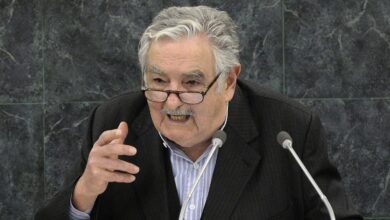Uruguayan Eduardo Galeano: Ten Years On, A Legacy Remembered

Ten years after the passing of Eduardo Galeano, the beloved Uruguayan journalist and writer, friends and family look back on his vibrant spirit—complete with piglet-collecting quirks and painterly barbecues—and reflect on how his generous soul continues to inspire today.
A Man of Piglets and Painterly Feasts
Eduardo Galeano’s life was a tapestry of literary brilliance and endearing eccentricities. “He identified with pigs,” recalls his daughter by adoption, Mariana ‘Pulga‘ Mactas, in an interview with EFE. She remembers his collection of ceramic piglets —chanchitos— lined up across his desk, each a small tribute to creatures he felt were unfairly maligned. “They call people pigs when they want to insult them, but pigs are clever and endearing,” he would say. So deeply did he empathize with them that his signature doodle featured one chewing a flower”, kind of like ‘Ferdinando el toro,'” Mactas adds, referencing the children’s tale Galeano passed along to her during her childhood.
Though Galeano’s aesthetic sense is often overshadowed by his best-known works—Open Veins of Latin America among them—he was, as his longtime friend Pedro Weinberg told EFE, “an esthetician at heart.” It shone through most vividly at the dinner table, especially when it was time for an asado. Far from tossing sausages and steaks haphazardly on the grill, Galeano arranged his ingredients like a painter composing a still life. “Visiting him wasn’t just about eating meat or having a glass,” Weinberg says. “It was about seeing how he placed everything on the grill, like mixing colors on a palette.” Galeano called the moment of lighting the fire la rompida del fuego —”breaking the fire”— turning what might have been an ordinary cookout into an immersive, almost ceremonial experience.
His daughter remembers him as the “creator of joy” in the family home, where Brazilian sambas, iconic Uruguayan tunes by Alfredo Zitarrosa, and even American folk from Bob Dylan scored day-to-day life. His open nature and eye for detail found their way into the simplest domestic scenes. Like his beloved piglets, those who entered his orbit felt seen and cherished.
The Writer Who Never Felt Like a Star
Although Galeano’s literary works sold globally —some claimed they were among the most stolen titles from bookstores— he never approached celebrity with arrogance. “He never considered himself a star,” Weinberg stresses to EFE, highlighting Galeano’s knack for humility. Even after publishing internationally acclaimed books and returning to Uruguay after years of exile in Argentina and Spain, Galeano remained intimately tied to Montevideo’s neighborhoods. His house, which he shared with his wife, Helena Villagra, was a continuous hub of fellow writers, painters, and musicians.
And yet, according to Weinberg, Uruguay itself doesn’t always trumpet Galeano’s achievements as loudly as other places do. “In this country, they don’t really bother,” he laments, noting that more libraries, schools, and cultural centers bear Galeano’s name in neighboring Argentina and in small Spanish towns than in his native land. Despite this, he’s consoled by the recognition Galeano still receives in the local Malvín neighborhood of Montevideo, where murals depict him, and neighbors speak fondly of the writer who never shunned everyday conversation.
Indeed, the imprint Galeano left on those around him was personal as much as it was literary. He once told friends that his books weren’t solely his creations he borrowed from memories, street scenes, fragments of dialogue overheard, and ephemeral flashes of life in Latin America. This collective spirit permeated his worldview. As Weinberg puts it, “He was a man who welcomed everyone into his circle and treated them with the same kindness.”
A Second Home in Café Brasilero
Near the city’s historic district stands the Café Brasilero, a traditional haunt that feels imbued with Galeano’s essence the instant visitors step inside. Its administrator, Santiago Gómez, explains to EFE that the establishment has been around for more than a century, but Galeano’s presence helped give it new life. “It was an extension of his house,” Gómez says, describing how Galeano made it a personal ritual to greet the staff, sit in his preferred spot, and sip a coffee or juice before delving into deep talks with artists, intellectuals, or old friends.
When the café changed management 16 years ago, the owners embedded a special clause in the lease: Galeano would always have a reserved table and a complimentary coffee. “He never took advantage of it,” Gómez laughs, noting the writer’s insistence on paying each time. “It was symbolic, really.” The significance of that arrangement lives on—countless visitors still leave sketches, postcards, or small tokens at the café, commemorating Galeano in his second home.
The bond between Galeano and this Montevideo institution reflects the synergy he built wherever he went. Whether at his own dinner table or in a public café, he bridged the gap between the writer perched at his desk and the everyday crowd. Even today, countless admirers drop by the Café Brasilero not just for a drink but to soak in the lingering presence of a man who, as Gómez observes, “will live on as long as these doors remain open.”
Life Open to Others, A Legacy That Endures
The artistic rituals of Eduardo Galeano’s life turned ordinary moments like eating grilled meats and collecting piglets into profound experiences. In Uruguay and other places he went beyond being just a famous writer. He established bonds as a friend while he hosted events graciously and observed life’s small details with curiosity.
He famously stated that his primary loyalty was to the people “below,” those marginalized or overshadowed by grand political narratives. This empathy drove him to produce works that, while poetically rendered, gave voice to struggles and hopes across Latin America. Today, on the tenth anniversary of his passing, that empathy resonates in the tributes scrawled on Malvín’s walls and in the continued affection of those, like Weinberg, who miss the man they consider “a very ‘lovable’ type.”
Also Read: Peruvian Titan Bids Farewell: Mario Vargas Llosa’s Influence
In the end, Galeano’s open-ended spirit remains a guiding light for anyone seeking human connection in a world prone to isolation. Whether strolling through Montevideo’s streets or seated in the warm wood-and-tile confines of Café Brasilero, his memory sparks an invitation to question reality, share stories, and find solidarity in the simplest acts of living—ever mindful of the wry, wondrous lens through which he viewed it all. As many who loved him insist, though he’s physically gone, the essence of Eduardo Galeano is far from lost—it’s stitched into every memory, every anecdote, and every battered copy of his books.




